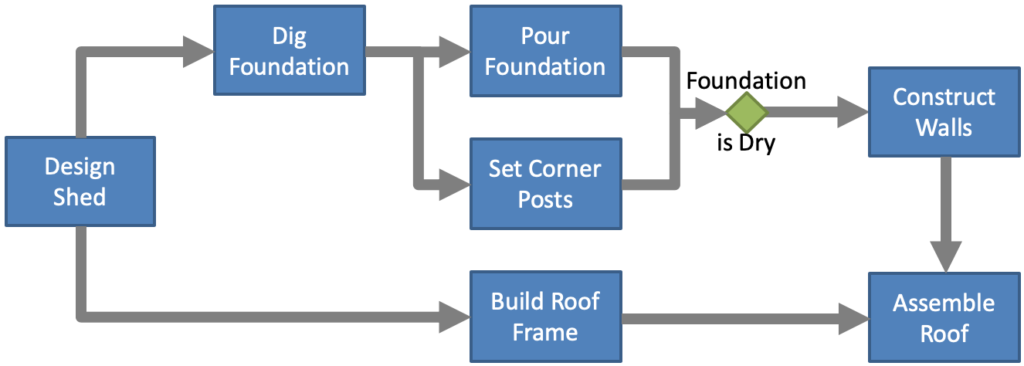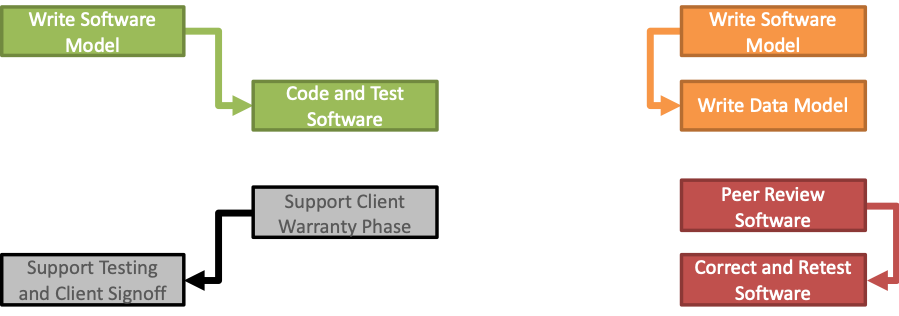Sequencing activities is often the first Schedule Management concept taught in project management classes, and the second topic covered by project management standards organizations behind scope definition. Despite activity sequencing’s prioritization in course material, its importance is often understated.
This article will review activity sequencing’s purpose with respect to project planning, the types of schedule logic dependencies and constraints, and schedule logic’s importance to a project in progress.
The Predictive Model
When building a shed, it makes little sense to start with the roof. The builder would soon run into steps requiring the construction of walls, a floor and a foundation before they can finish the roof. However, if rain delays pouring the concrete foundation, assembling the roof frame may let the builder make use of otherwise lost time.

Whether a project is very well understood, or a new endeavor for the project team, establishing the logical sequence of events takes a project from an abstract concept to a plan of attack. Activity sequencing tells team members what needs to be done, and what needs to be done next. In the middle of a project, if an obstacle is encountered, a properly sequenced schedule will help the project team identify how to work around the obstacle rather than risk standstill.

The more nebulous or uncertain a project is, the more critical a role activity sequencing (often referred to as building a network diagram) plays in keeping project teams focused. The network diagram also tells the project team how the work outside of their sphere of influence will unfold. Even without resource loading or task durations to establish the project’s critical path, the network diagram tells the project team what activities or what sequence of activities will conclude the project.
Types of Dependencies
Predecessor/successor relationships between tasks form the backbone of a schedule’s logical sequencing. A schedule is said to have good horizontal traceability if all tasks have clear connections between the beginning and the end of a project.
Task dependencies can be categorized as internal or external. Internal dependencies (also called intradependencies) are dependencies between any two tasks or milestones within the project file. An external dependency is a relationship between any task or milestone on the project schedule, and an event that is outside the project’s control.
If an organization is supporting multiple interrelated projects, it is possible that those project files will share one or more interdependencies.1Grammatical point of order: Intra means “within” (e.g. intravenous). Inter means “between” (e.g. interstate). For almost all practical purposes, these interdependencies are treated either as internal dependencies or external dependencies, depending whether the project schedules are maintained as a single project file or multiple project files.

Though the project manager may be able to influence an outside organization’s activities, the schedule manager and project team by definition have no direct control over external events. Simplicity dictates that schedule managers should only concern themselves with details they and their project team can take responsibility for. Thus, external dependencies are best represented as zero-duration milestones. This keeps the schedule manager’s focus on the external dependency’s most important component, the handoff date.
Internal dependencies are more complex because the project manager must also consider how the tasks’ durations affect their relationship. Of the four potential dependency relationships described in Figure 4, only the Finish-Start and Start-Start dependencies are recommended for practical use. Finish-Finish and Start-Finish dependencies significantly complicate schedule logic and can cause a project schedule to become inviable.

Lag and Constraint Dates
Task dependencies are sometimes augmented by lag or constraint dates. Lag usually represents an event or a circumstance that is outside the project team’s control, such as the time for cement to dry or days a client has requested to review a document. Sometimes, as depicted on the right side of Figure 5, a lag is established between two tasks to signify progress that must be accomplished on the first task before the second task can proceed. Negative task lag, also called a task lead, is sometimes used to describe partially concurrent tasks. However negative lag can create unnecessary complications to schedule logic.

Constraint dates are used to define when a task should start or finish. They can be used to anchor an external dependency, the start of a project, or a major milestone whose date cannot be sensibly defined by predecessor / successor dependencies or resource leveling.
Constraint dates are considered soft when they have the flexibility to shift in one direction. For example, a Start No Earlier Than (SNET) constraint specifies that a task or a milestone cannot start earlier than a specified date but may start later. Hard constraints (Must Start On/Must Finish On) specify a fixed date which prevents a task from shifting earlier or later. A hard constraint also forces the task or milestone onto the project’s critical path, regardless of available slack in the schedule.
Schedule Logic’s Importance to a Project in Progress
No project of significant size goes perfectly according to plan. To stay on schedule, the project team must proactively address obstacles and delays. If a schedule’s activities are properly sequenced, the schedule will show which tasks are impacted by a delay, the extent of the delay, and which tasks can be reprioritized to make up for lost time. Events that cause a significant delay in week 4 of a project, may be able to be mitigated by week 6, with no further impact down the line. When the schedule’s internal and external dependencies are able to reliably predict what must happen and when, it enables the project team to make informed decisions about how to continue, as well as setting realistic expectations for all stakeholders.

Lastly, a properly sequenced and resource loaded project schedule allows project and schedule managers to balance activity constraints with resource constraints. Proper activity sequencing lets the schedule manager forecast when the project team will be overloaded or underloaded. This allows managers to reduce bottlenecks and crunch times not only in the planning phase of a project, but also during the project’s execution.
Next Steps
This article has discussed the importance of activity dependencies and sequencing to Schedule Creation and how project teams rely on schedule logic to maintain their pace of work. It has also overviewed the types of internal and external dependencies at the schedule manager’s disposal.
The quality of a project’s schedule logic determines the achievability, reliability and utility of the schedule file. Schedule Logic Principles will discuss the proper use of predecessor and successor relationships, lag, and constraint dates when creating and maintaining a project schedule.
